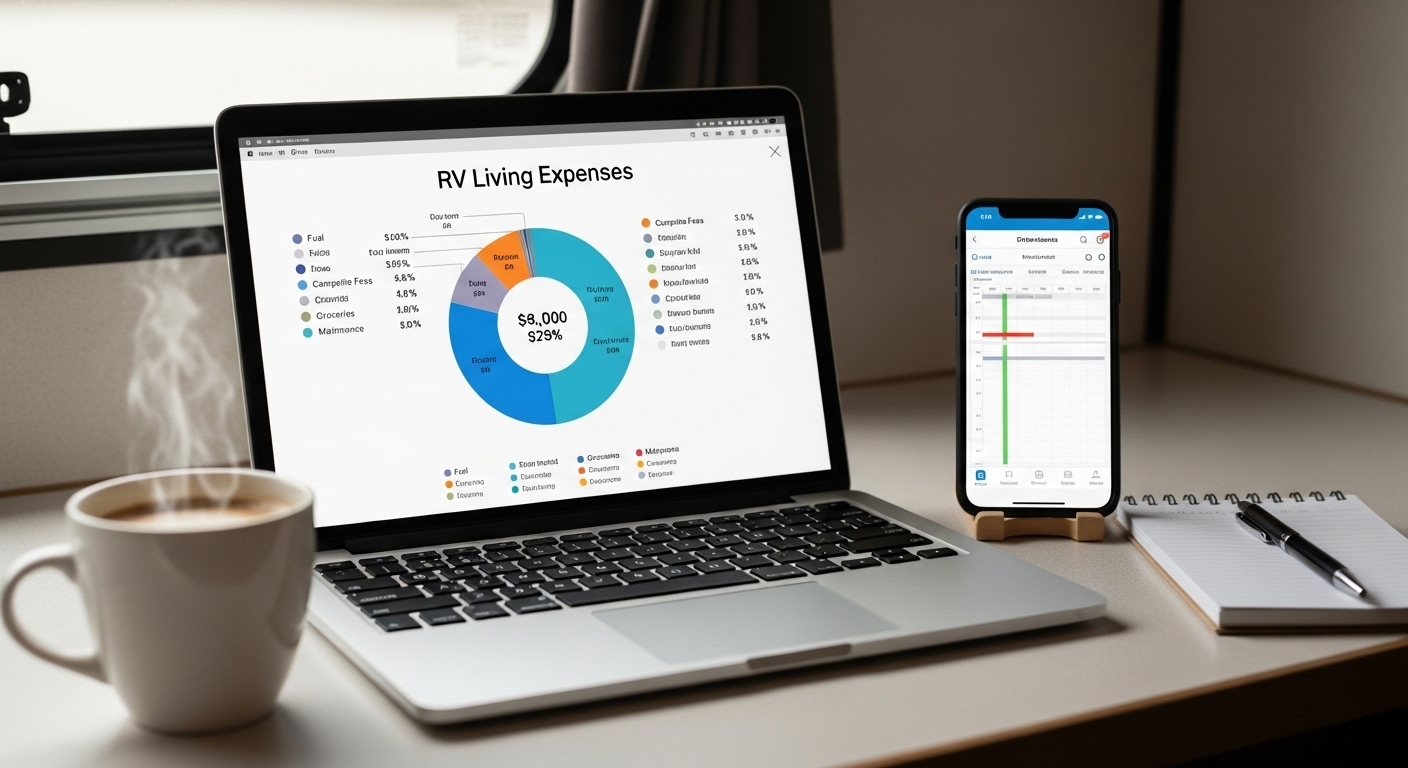
How to Budget for Full-Time RV Living: Complete Cost Breakdown
One of the most common questions from aspiring full-time RVers is: "How much does it actually cost?" The answer varies significantly based on lifestyle choices, travel habits, and personal preferences. This comprehensive guide breaks down real costs and provides strategies for budgeting successfully in your RV life.
Initial Investment Costs
RV Purchase
Prices range dramatically based on type and age. Used Class B vans start around $30,000-50,000, while new Class A motorhomes can exceed $200,000. Consider financing costs if applicable—typical RV loans run 10-20 years at 4-9% interest.
Tow Vehicle (if needed)
Travel trailers and fifth wheels require capable tow vehicles, adding $25,000-60,000 to initial costs. Factor in modifications like brake controllers and weight distribution hitches ($500-2,000).
Initial Setup and Modifications
Budget $2,000-10,000 for essential upgrades: solar panels, mattress upgrades, WiFi boosters, security systems, and organizational solutions. Many RVers underestimate these costs.

Fixed Monthly Costs
Insurance ($75-300/month)
RV insurance costs depend on RV value, coverage level, and driver history. Full-timers need specialized policies covering personal belongings and liability. Shop multiple companies for best rates.
Phone and Internet ($100-200/month)
Reliable connectivity often requires multiple carriers and data plans. Many full-timers spend $150+ monthly for unlimited data through Verizon, AT&T, or T-Mobile, plus WiFi boosters.
Health Insurance ($200-800/month)
Major expense for full-timers under 65. Options include ACA marketplace plans, health sharing ministries, or employer coverage for remote workers. Medicare simplifies this for retirees.
Storage Unit (optional, $50-200/month)
Some full-timers keep storage units for seasonal items, business inventory, or sentimental belongings. Climate-controlled units cost more but protect valuables.
Variable Monthly Costs
Campground Fees ($0-2,000/month)
Widest variation in RV budgets. Free boondocking costs nothing, while luxury RV resorts run $60-100+ nightly. Most full-timers average $500-1,000 monthly mixing campground types:
- Boondocking (Free): Public lands, parking lots, requires self-sufficiency
- State/National Parks ($20-50/night): Beautiful locations, often 14-day limits
- Private Campgrounds ($30-80/night): Full hookups, amenities, monthly discounts
- Membership Programs ($500-3,000/year): Thousand Trails, Passport America offer significant savings
Fuel ($200-800/month)
Depends heavily on travel frequency and RV type. Motorhomes get 6-12 MPG, while trucks towing trailers achieve 10-15 MPG. Slow travel (staying longer in each location) dramatically reduces fuel costs.
Food and Groceries ($300-600/month)
Similar to stick-and-brick living, though some report higher costs from shopping at convenience stores or eating out more. Meal planning and cooking in your RV saves significantly compared to restaurants.
Propane ($20-60/month)
Powers refrigerator, stove, water heater, and furnace. Usage varies by climate and appliance efficiency. Summer boondockers use minimal propane, while winter campers consume much more.

Electricity ($0-100/month)
Usually included in campground fees. Occasional additional charges at metered sites. Solar panels eliminate this cost when boondocking.
Laundry ($20-40/month)
Campground facilities or laundromats run $4-8 per load. Some RVers install compact washers or use laundry delivery services.
Maintenance and Repairs ($100-500/month)
Budget 1-3% of RV value annually for maintenance. Older RVs require more repairs. Set aside money monthly for these inevitable expenses:
- Oil changes and routine vehicle maintenance
- Tire replacements (expensive—$200-400 per tire)
- Appliance repairs and replacements
- Roof resealing and water damage prevention
- Generator maintenance
- Battery replacements
Emergency repairs can be costly. Many RVers keep $3,000-5,000 emergency fund specifically for unexpected breakdowns.
Miscellaneous Costs
Entertainment and Activities ($100-300/month)
National park passes ($80 annual), attraction admissions, outdoor gear, hobbies, and entertainment. RV life offers abundant free activities—hiking, beaches, wildlife watching.
Mail Forwarding ($10-30/month)
Services like Escapees or Americas Mailbox provide domicile addresses and scan/forward mail. Essential for full-timers without permanent address.
RV Park Memberships ($40-250/year)
Good Sam, Passport America, Harvest Hosts, and Boondockers Welcome offer discounts and free camping opportunities. Memberships pay for themselves quickly.
Pets ($50-150/month)
Pet fees at campgrounds ($1-5 daily), food, veterinary care, and supplies. Many campgrounds limit pet breeds or sizes.
Sample Monthly Budgets
Ultra-Budget RV Living ($1,500-2,000/month)
- Free boondocking primarily
- Minimal travel between locations
- DIY repairs and maintenance
- Cook all meals in RV
- Minimize subscriptions and memberships
- Part-time work or social security income
Moderate Comfort ($2,500-3,500/month)
- Mix of campgrounds and boondocking
- Regular travel to new locations
- Occasional dining out and entertainment
- Reliable internet for remote work
- Professional maintenance when needed
- Comfortable but not extravagant lifestyle
Luxury RV Life ($4,000-6,000+/month)
- Premium RV parks and resorts
- Frequent travel and exploration
- Regular dining out and activities
- Professional maintenance and upgrades
- Multiple subscription services
- Comfortable financial cushion
Money-Saving Strategies
Slow Travel
Stay longer in each location to reduce fuel costs and discover free activities. Many campgrounds offer weekly/monthly discounts that significantly reduce per-night costs.
Boondocking
Master free camping on public lands, parking lots, and through host programs. Invest in solar power and large water tanks for self-sufficiency.
Work Camping
Trade labor for free campsite and sometimes additional income. Amazon CamperForce, national park jobs, and private campground positions offer opportunities.
Remote Work
Maintain steady income while traveling. Many careers translate well to remote work—virtual assistants, writers, programmers, customer service, and consultants thrive in RV life.
Membership Discounts
Join Good Sam, AARP, AAA, and military groups for camping discounts, fuel savings, and reduced insurance rates. Discounts quickly offset membership costs.
DIY Maintenance
Learn basic repairs through YouTube tutorials and RV forums. RV service labor costs $75-150 per hour—doing it yourself saves significantly.
Tracking Your Budget
Use budgeting apps or spreadsheets to track actual spending. Popular options include:
- Mint or YNAB: Comprehensive budgeting with automatic transaction categorization
- RV-specific Apps: RV Expenses tracks costs specific to RV living
- Simple Spreadsheets: Create custom categories matching your lifestyle
- Cash Envelope System: Allocate cash for variable categories to control spending
Review monthly to identify cost patterns and adjustment opportunities. Most RVers find their spending stabilizes after the first 3-6 months as they refine their lifestyle.
Final Budgeting Tips
Start with Higher Budget: Expect higher costs initially as you outfit your RV and learn efficient systems. Costs typically decrease after the first year.
Build Emergency Fund: Aim for 3-6 months expenses in savings. RV repairs and unexpected issues happen—being prepared reduces stress.
Stay Flexible: Your budget will evolve. What works for others might not suit your lifestyle. Adjust based on priorities and happiness, not arbitrary numbers.
Consider Residual Income: Solar investment, fuel efficiency upgrades, and quality equipment often pay for themselves through reduced ongoing costs.
Full-time RV living can fit various budgets. Whether you're minimizing expenses or enjoying luxury travel, careful planning and tracking ensure financial sustainability. The key is aligning spending with values—prioritize what matters to you, cut ruthlessly where it doesn't. Financial freedom in RV life comes from intentional choices, not deprivation. Start planning your budget today and take the first step toward your RV adventure!